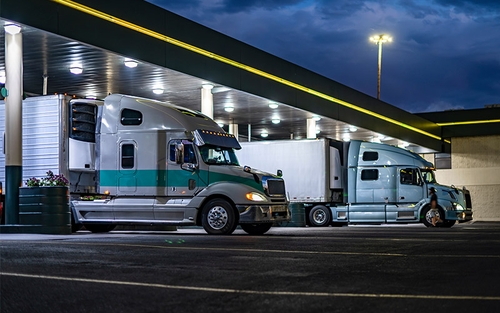Trucking company compliance checklist for owner-operators
January 31, 2023

Estimated reading time: 5 minutes
Whether your business is an owner-operator running under another carrier’s authority, or your business obtained its own motor carrier authority, a best practice is to always stay up to date on the Department of Transportation (DOT) and Federal Motor Carrier Safety Administration (FMCSA) regulations in order to stay compliant and safe while out on the road.
In this blog, we’ll take you through a trucking company compliance checklist to help outline some of the things to consider to keep your business operating safely. This is not an exhaustive list of all items or regulations that you need to understand, but it will certainly give your business some items to think about!
This content will focus on interstate carrier requirements. For intrastate carrier requirements, check your state’s regulations.
What is trucking compliance?
Generally, trucking compliance is when truck drivers and trucking companies successfully meet requirements laid out by the federal government.
No matter what type of freight you haul, and whether your business runs under its own or another motor carrier’s operating authority, it’s important for owner-operators to stay compliant with these regulations, which include, among others:
- Understanding federal drug and alcohol policies.
- Meeting driver requirements, both for owner-operators and the drivers they employ.
- Keeping up with equipment maintenance.
- Following business and registration filings.
If you do business with a carrier, many of the items in this checklist may be completed by the carrier. If you operate under your own authority, additional steps may be needed to be compliant.
5 step trucking company compliance checklist
| Owner-operators who run under their own authority | Owner-operators who do business with a carrier | |
| Enroll in a drug and alcohol consortium | X | |
| Register with the FMCSA Clearinghouse | X | X |
| Create a driver qualification file | X | |
| Determine if you require an ELD | X | X* |
| Conduct vehicle inspections | X | X |
| Be prepared for a DOT audit | X |
1. Enroll in a drug and alcohol consortium.
Owner-operators who run under their own authority
DOT requirements for owner-operators include participation in a DOT Drug & Alcohol Testing Program, according to the regulations established by the Federal Motor Carrier Safety Administration.
Owner-operators running under their own authority must register with a consortium, where they will be entered into a random testing pool. You can find a DOT consortium by:
- Searching online using the keywords “Consortium DOT Drug & Alcohol Testing owner-operator.”
- Seeking advice from trucking organizations in your area.
- Searching the yellow pages.
Owner-operators who do business with a carrier
If you do business with a carrier, like Schneider, you should be automatically enrolled into the carrier’s consortium.
All owner-operators
Every owner-operator, regardless of whether they do business with a carrier or operate under their own authority, needs to register as a driver with the FMCSA Clearinghouse.
Owner-operators running under their own USDOT number need to register both driver and employer Clearinghouse roles.
2. Create a driver qualification file.
Owner-operators who run under their own authority
FMCSA regulations require trucking companies to maintain a driver qualification file for every driver.
Owner-operators running under their own authority should have this information on themselves, plus any drivers they employ. According to the FMCSA, some of the information the file should include is as follows:
- Employee application complying with federal requirements.
- Motor Vehicle Report.
- Copy of their CDL if accepting in lieu of a road test.
- Pre-employment drug and alcohol documents.
- DOT physical report.
- Prior employment checks – safety performance history.
You can also choose to run a criminal background check and PSP report, although this is not a requirement.
For more details on the full requirements for the driver qualification file, make sure to read the FMCSA regulations.
You can keep the file wherever you store important documents but know you should have quick access to the records to be able to submit them within 48 hours.
Owner-operators who do business with a carrier
If you do business with a carrier, the carrier will maintain this information for you.
3. Determine if you require an ELD.
Owner-operators who run under their own authority
Most motor carriers and drivers who are required to keep a record of duty status (RODS) need to have an electronic logging device (ELD), according to the FMCSA.
Owner-operators running under their own authority need to check if the ELD rule applies to them. Some exemptions include:
- Drivers who use paper logs (qualify for short-haul) no more than eight days during any 30-day period.
- Driveaway-towaway drivers.
- Drivers of trucks manufactured before model year 2000.
If you don’t fall under these exemptions and you’re running under your own authority, you’ll likely need to get an ELD from a provider that is certified and registered with the FMCSA.
Owner-operators who do business with a carrier
If you do business with a carrier, ask if they will give you an ELD and provider, or if you need to get your own.
At Schneider, for example, we install ELDs. The owner-operator is responsible for daily accuracy and review of the ELD’s records.
4. Conduct vehicle inspections.
All owner-operators need to conduct post-trip and pre-trip inspections on their truck to keep up with FMCSA requirements. If you’re stopped for a roadside inspection, having done your inspections will help ensure your business stays compliant.
Post-trip inspection
According to FMCSA regulations, at the end of each workday owner-operators need to inspect their trucks to ensure everything is in proper operating condition. Owner-operators should inspect and evaluate at least the following parts and accessories:
- Service brakes, including trailer brake connections.
- Parking (hand) brake.
- Steering mechanism.
- Lighting devices and reflectors.
- Tires.
- Horn.
- Windshield wipers.
- Rear-vision mirrors.
- Coupling devices.
- Wheels and rims.
- Emergency equipment.
If there’s a defect, owner-operators need to document it and submit a written report. The issue must be repaired before the truck is dispatched again if the issue is likely to affect the safety of the operation of the vehicle.
Pre-trip inspection
Before getting on the road, owner-operators must make sure their truck is safe to operate. Re-check the same parts and accessories from your post-trip inspection. In addition, ensure the freight you’re going to move is secured.
If the last vehicle inspection report notes any deficiencies, the owner-operator needs to review and sign the report to certify that the proper repairs were made.
Otherwise, there’s no paperwork for a pre-trip inspection.
5. Be prepared for your audit.
Owner-operators who run under their own authority
A new trucking company must undergo a New Entrant Safety Assurance Audit during its first 18 months of business.
If you run under your own authority, this applies to your business. The information in your driver qualification files will help prepare you for a DOT audit. In addition to that information, you’ll also need, at a minimum:
- A list of your truck(s) and trailer(s).
- Proof of active insurance.
- A statement of your on-duty hours.
- Records of maintenance on your truck(s) and trailers(s).
The FMCSA may request that you provide additional information as well. So, the best practice is to stay up-to-speed on the requirements of the FMCSA regulations, and keep your information organized and accessible!
Owner-operators who do business with a carrier
For owner-operators who do business with a carrier, like Schneider, the carrier is audited for the new entrant safety audit.



